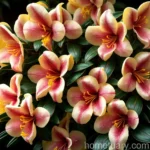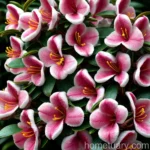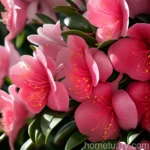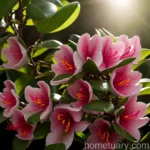Rhododendron (Rhododendron ‘Hawaii’): A Comprehensive Guide

Rhododendron ‘Hawaii’ is a stunning cultivar that adds a burst of vibrant color to any garden. With its beautiful flowers and lush foliage, this plant is a favorite among gardeners and landscape enthusiasts. In this comprehensive guide, we will delve into the intricacies of caring for and cultivating the rhododendron ‘Hawaii’. From its cultural requirements to its maintenance, propagation, and common diseases and pests, we will cover everything you need to know to ensure the successful growth of this exquisite plant.
What is Rhododendron ‘Hawaii’?
Rhododendron ‘Hawaii’ is a cultivar of the evergreen shrub Rhododendron. Known for its large, showy flowers, this plant forms a dense, rounded shape and is prized for its ornamental value. Originating from the Rhododendron species, ‘Hawaii’ boasts striking pinkish-red blooms that emerge in mid-season, adding a spectacular display of color to the garden.
This cultivar is beloved for its exceptional visual appeal and is often used as a focal point in landscapes and gardens. With proper care and maintenance, Rhododendron ‘Hawaii’ can thrive and bring joy to gardeners with its vibrant flowering display.
Key Takeaways – Rhododendron ‘Hawaii’
Before we delve into the specifics of caring for Rhododendron ‘Hawaii’, let’s take a look at the key takeaways for this stunning cultivar:
- Scientific Name: Rhododendron ‘Hawaii’
- Common Name: Hawaii Rhododendron
- Plant Type: Evergreen shrub
- Flower Color: Pinkish-red
- Cultural Requirements: Well-drained soil, acidic conditions, partial shade, regular watering
- Maintenance: Regular pruning after flowering, protection from harsh winter conditions
- Uses: Ornamental shrub, landscaping, focal point in gardens
Now, let’s delve into the detailed care and cultivation requirements for Rhododendron ‘Hawaii’.
Culture
Cultivating Rhododendron ‘Hawaii’ requires an understanding of its cultural needs, including soil, sunlight, water, and fertilizer requirements.
Soil
Rhododendron ‘Hawaii’ thrives in well-drained, acidic soil. The ideal pH range for this plant is between 4.5 to 6.0. It’s essential to ensure that the soil provides good aeration and drainage to prevent waterlogged conditions, which can be detrimental to the plant’s health.
Gardeners can improve the soil’s acidity by incorporating organic matter such as pine bark, peat moss, or compost. These amendments not only enhance the pH but also contribute to the soil’s structure and overall quality.
Water
Proper watering is crucial for the health and vitality of Rhododendron ‘Hawaii’. While it is important to maintain moist soil, waterlogged conditions should be avoided. During the growing season, the plant benefits from consistent moisture. However, it’s equally important to allow the soil to dry slightly between watering sessions to prevent root rot.
An effective way to water Rhododendron ‘Hawaii’ is through a slow, deep watering method, which ensures that the moisture reaches the plant’s deep roots. Additionally, using a layer of mulch around the base of the plant helps retain soil moisture and regulate temperature fluctuations.
Sunlight
Partial shade is ideal for Rhododendron ‘Hawaii’. While the plant requires some sunlight to promote flowering, excessive exposure to direct sunlight, especially during the hot afternoon hours, can cause stress and lead to sunburned leaves. Selecting a location with dappled sunlight or partial shade, especially in warmer climates, is advantageous for the overall health of the plant.
Fertilizer
Fertilizing Rhododendron ‘Hawaii’ is essential to ensure optimal growth and prolific flowering. A balanced, acidic fertilizer formulated for rhododendrons and azaleas can be applied in spring after the threat of frost has passed. Moreover, a second application can be made in late summer to provide the plant with essential nutrients for the upcoming growing season.
It’s important to follow the instructions on the fertilizer package to avoid over-fertilization, and applying fertilizer to moist soil can help prevent root burn.
Pruning
Pruning is an essential aspect of maintaining the health, shape, and flowering potential of Rhododendron ‘Hawaii’. Regular pruning should be performed after the plant has finished flowering. This allows the plant to redirect its energy to the development of new growth and flower buds for the following season.
The pruning process involves removing spent flowers, dead or damaged branches, and shaping the plant as desired. Care should be taken to avoid excessive pruning during late summer or fall, as this can remove the flower buds and diminish the next season’s floral display.
Propagation
Propagating Rhododendron ‘Hawaii’ can be done through several methods, including:
-
Cuttings: Taking semi-hardwood cuttings offers a reliable method for propagating Rhododendron ‘Hawaii’. The cuttings should be collected from healthy, disease-free branches and treated with a rooting hormone before being placed in a suitable medium for root development.
-
Layering: Air layering is another effective propagation technique for Rhododendron ‘Hawaii’. This method involves creating a wound on a healthy branch, applying rooting hormone, and wrapping the area with moist sphagnum moss and plastic. Once roots develop, the new plant can be separated and transplanted.
-
Seeds: While growing Rhododendron ‘Hawaii’ from seeds is possible, it requires patience and specific environmental conditions for successful germination and growth.
Container Popularity
Rhododendron ‘Hawai’i is a popular choice for container gardening, especially for gardeners with limited space or those seeking to add vibrant colors to patios, decks, or balconies. When selecting a container for this plant, it’s crucial to consider the following factors:
-
Size: Choose a container that provides ample space for the plant’s roots to grow and develop. The container should also offer good drainage to prevent waterlogging.
-
Material: Opt for containers made of durable, weather-resistant materials that complement the plant’s ornamental qualities while ensuring longevity.
-
Soil: Use a well-draining potting mix formulated for acid-loving plants to provide the necessary growing medium for Rhododendron ‘Hawaii’ in a container.
-
Placement: Position the container in a location that provides partial shade and shelter from harsh winds, especially during the hottest part of the day.
Common Diseases
Despite its ornamental appeal, Rhododendron ‘Hawaii’ is susceptible to certain diseases. Understanding these common ailments and their prevention measures is essential for maintaining the plant’s health. Some of the common diseases affecting Rhododendron ‘Hawaii’ include:
-
Powdery Mildew: This fungal disease appears as a white, powdery substance on the leaves, stems, and buds. Proper air circulation, reduced humidity, and the application of fungicidal sprays can help prevent and manage powdery mildew.
-
Phytophthora Root Rot: Excessive soil moisture and poor drainage can promote the development of phytophthora root rot. To prevent this disease, it’s essential to ensure proper watering practices and maintain well-drained soil conditions.
-
Leaf Spot: Leaf spot diseases manifest as dark, spotted lesions on the foliage. Pruning affected branches, promoting good air circulation, and avoiding overhead watering can help prevent the spread of leaf spot diseases.
Disease Diagnosis
Diagnosing diseases affecting Rhododendron ‘Hawaii’ requires keen observation of the plant’s symptoms and characteristics associated with specific ailments. Visual cues such as foliage discoloration, wilting, or the presence of abnormal growths can aid in identifying the potential disease affecting the plant.
Performing a thorough inspection of the plant, including the upper and lower leaf surfaces, stems, and buds, can provide valuable insights into the underlying issues. Consulting with a professional plant pathologist or horticulturist can also help in accurate disease diagnosis and the development of a targeted management strategy.
Common Pests
Rhododendron ‘Hawaii’ is susceptible to infestations by several pests, including:
-
Aphids: These small, sap-sucking insects can cause stunted growth and distorted foliage. Insecticidal soaps or horticultural oils can be used to manage aphid populations.
-
Thrips: Thrips are tiny, slender insects that feed on plant fluids, leading to silvering or bronzing of the foliage. Applying neem oil or insecticidal sprays can help control thrips infestations.
-
Spider Mites: Spider mites are common pests that thrive in hot, dry conditions. Regularly spraying the plant with water and applying miticides can help manage spider mite populations.
Botanist’s Tips
To ensure the successful cultivation and maintenance of Rhododendron ‘Hawaii’, consider the following botanist’s tips:
-
Prune Wisely: When pruning Rhododendron ‘Hawaii’, avoid heavy, drastic cuts that can stress the plant. Instead, aim for selective, well-planned pruning to maintain the plant’s natural form and encourage healthy growth.
-
Monitor Soil Moisture: Keep a close eye on the moisture levels in the soil, especially during periods of high temperatures or excessive rainfall. Adjust watering practices accordingly to avoid waterlogged or drought-stressed conditions.
-
Protect from Harsh Weather: In regions with extreme winter conditions, provide protection for Rhododendron ‘Hawaii’ by applying a layer of mulch around the base of the plant and covering it with burlap or a protective cloth to shield it from harsh winds and freezing temperatures.
-
Integrated Pest Management: Implement an integrated approach to pest management, incorporating cultural, mechanical, and biological control methods alongside judicious use of pesticides to maintain a balanced ecosystem and minimize environmental impact.
Fun Facts
- Rhododendron ‘Hawaii’ belongs to the family Ericaceae, which includes various acid-loving plants such as azaleas, heathers, and blueberries.
- The name “rhododendron” is derived from the Greek words “rhodon,” meaning rose, and “dendron,” meaning tree, reflecting the plant’s exquisite floral displays resembling roses.
- “Hawaii” is derived from the Hawaiian Islands, known for their stunning natural landscapes and diverse flora, reflecting the vibrancy and beauty of the Rhododendron ‘Hawaii’ cultivar.
- Rhododendrons are native to diverse regions, including the Himalayas, China, and North America, and encompass a wide array of species and cultivars, each with unique characteristics and adaptations to different climates and environments.
Links to External Resources
For further information on Rhododendron ‘Hawaii’, including care tips, landscaping ideas, and in-depth plant characteristics, consider exploring these external resources:
- American Rhododendron Society
- Royal Horticultural Society – Rhododendron Care
- The Rhododendron Species Foundation & Botanical Garden
In conclusion, Rhododendron ‘Hawaii’ represents a captivating addition to any garden or landscape. Its delightful blooms, evergreen foliage, and ornamental qualities make it an exquisite choice for gardeners seeking to introduce vibrant colors and visual interest to their outdoor spaces. By understanding and implementing the recommended care and cultivation practices, enthusiasts can enjoy the beauty of Rhododendron ‘Hawaii’ and create a thriving environment for this remarkable plant.
Remember, the key to successful gardening lies in patience, observation, and a genuine passion for nurturing plants. With each season, Rhododendron ‘Hawaii’ offers new blooms and the promise of a flourishing, ever-evolving garden landscape.
Keywords: Rhododendron care tips, Rhododendron ‘Hawaii’ information, Growing Rhododendron ‘Hawaii’, Rhododendron varieties, Rhododendron species, Rhododendron pruning techniques, Rhododendron planting guide, Rhododendron ‘Hawaii’ characteristics, Rhododendron ‘Hawaii’ blooms, Rhododendron ‘Hawaii’ maintenance, Rhododendron ‘Hawaii’ landscaping, Rhododendron ‘Hawaii’ diseases, Rhododendron ‘Hawaii’ pests, Rhododendron ‘Hawaii’ watering needs, Rhododendron ‘Hawaii’ soil requirements, Rhododendron ‘Hawaii’ propagation methods, Rhododendron ‘Hawaii’ fertilization tips, Rhododendron ‘Hawaii’ sunlight requirements, Rhododendron ‘Hawaii’ temperature tolerance, Rhododendron ‘Hawaii’ pruning schedule, Rhododendron ‘Hawaii’ landscape design ideas, Rhododendron ‘Hawaii’ container gardening, Rhododendron ‘Hawaii’ companion plants, Rhododendron ‘Hawaii’ winter care, Rhododendron ‘Hawaii’ spring blooms, Rhododendron ‘Hawaii’ summer maintenance, Rhododendron ‘Hawaii’ fall preparation, Rhododendron ‘Hawaii’ garden design, Rhododendron ‘Hawaii’ natural habitat, Rhododendron ‘Hawaii’ garden edging ideas, Rhododendron ‘Hawaii’ soil pH requirements, Rhododendron ‘Hawaii’ mulching techniques, Rhododendron ‘Hawaii’ water drainage, Rhododendron ‘Hawaii’ container size recommendations, Rhododendron ‘Hawaii’ flowering season, Rhododendron ‘Hawaii’ pruning tools, Rhododendron ‘Hawaii’ disease prevention, Rhododendron ‘Hawaii’ pest control methods, Rhododendron ‘Hawaii’ sunlight exposure, Rhododendron ‘Hawaii’ drought tolerance, Rhododendron ‘Hawaii’ irrigation tips, Rhododendron ‘Hawaii’ soil amendments, Rhododendron ‘Hawaii’ transplanting guide, Rhododendron ‘Hawaii’ landscape borders, Rhododendron ‘Hawaii’ pollination process, Rhododendron ‘Hawaii’ bloom color variations, Rhododendron ‘Hawaii’ root development, Rhododendron ‘Hawaii’ winter protection, Rhododendron ‘Hawaii’ fertilizing schedule, Rhododendron ‘Hawaii’ planting depth















